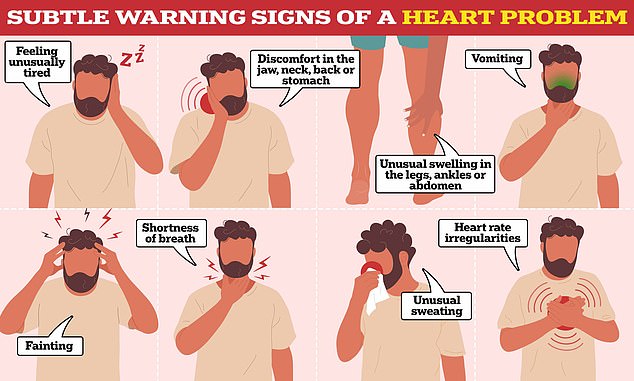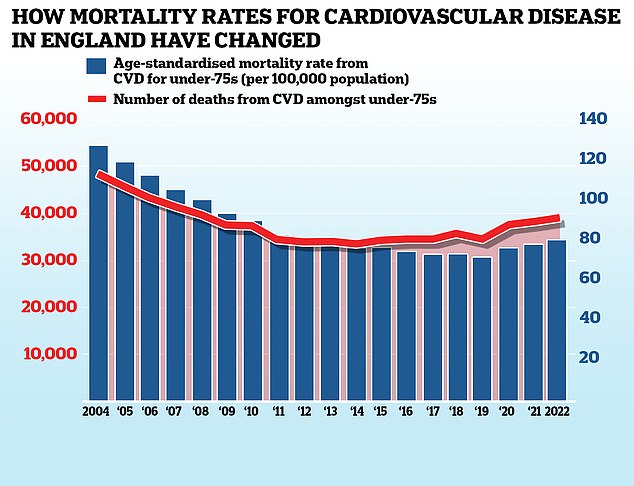Families of cancer patients are almost a third more likely to suffer from life-threatening heart disease a year after their relative’s diagnosis, grim research suggests.
Experiencing a loved one receiving a diagnosis is often stressful and traumatic for the entire family.
But American scientists who followed more than 150,000 family members found that they had a 28 percent higher risk of developing cardiovascular disease one year later.
They were also 10 percent more likely to develop a psychological illness.
Experts today attributed the increased risk to financial pressures and the emotional impact of treatment, urging health professionals to take these findings into account.
The experience of a loved one receiving a diagnosis is often stressful and traumatic for the whole family. Pictured here, bowel cancer campaigner Dame Deborah James with her mother (centre) and daughter. Last year, her mother Heather James told The Times: “I think we’re all coping. Well, I wasn’t last year. I had a real panic attack on the anniversary of her death.”

Pictured: Dame Deborah James with her husband, two children and the Prince of Wales in 2022.

While some warning signs are easy to spot, such as severe chest pain, others are more vague and difficult to pinpoint.
This also comes just months after charities warned the NHS was suffering its “worst cardiac care crisis in living memory”.
Dr. Mouneeb Choudry, senior author of the study and a Mayo Clinic urology expert, said: ‘A cancer diagnosis is a life-changing event for patients and their families.
‘Thanks to our group’s unique access to Utah’s population database, we were able to create multigenerational networks that highlight the impact of a cancer diagnosis on families.
‘As healthcare professionals, we must take a multidisciplinary approach to addressing the stress of a cancer diagnosis, helping to mitigate the financial toxicity, burden of treatment and emotional impact on both the patient and their family.’
In the study, University of Utah researchers evaluated health data from 77,938 family members and spouses of nearly 50,000 patients who had been diagnosed with cancer between 1990 and 2015.
They compared this data with that of 81,022 relatives and spouses of nearly 250,000 people who had not received a cancer diagnosis.
The scientists found that 7.1 percent of family members overall were diagnosed with a psychological illness within five years of diagnosis, and the figure was 7.6 percent for cardiovascular disease.
After one year, the risk of cardiovascular disease was 28 percent higher, and after three and five years it was 16 and 14 percent, respectively.
There was also a 10 percent higher chance of developing a psychological disorder after one year.
This figure dropped to five and four percent after three and five years.
Writing in the diary CancerResearchers warned that parents of children with cancer experienced the highest risks, almost four times higher per year, compared to other relatives.
Diagnoses of kidney and bladder cancer also appeared to be the most stressful, they added, with testicular cancer being the least stressful.
This comes as data from earlier this year revealed that premature deaths from cardiovascular problems, such as heart attacks and strokes, have reached their highest level in more than a decade.
Cases of heart attacks, heart failure and strokes among those under 75 had been declining since the 1960s thanks to falling smoking rates, advanced surgical techniques and advances such as stents and statins.
But rising obesity rates and its catalogue of associated health problems, such as high blood pressure and diabetes, are now thought to be one of the main contributing factors.

This chart shows the death rate from cardiovascular disease in people under 75 in England (blue bars), which is the number of deaths per 100,000 people, as well as the total number of deaths (red line). Medical advances and advanced screening techniques helped to reduce these figures from 2004 onwards, but progress began to stall in the early 2010s before reversing in recent years of data.
Slow ambulance response times for Category 2 calls in England (which include suspected heart attacks and strokes), as well as long waits for tests and treatment, have also been blamed for the rise, which is also being felt in younger adults.
Despite claims by anti-vaxxers, cardiologists say fears that Covid vaccines may have fuelled a rise in heart problems are far from true.
The data also shows that detecting cancer early, when it is most treatable, can increase survival chances by up to eight times.
In England, more than 320,000 people (or 900 a day) are diagnosed with cancer every year, with the most common types being prostate, breast, bowel and lung.
But NHS cancer services repeatedly fail to meet their targets.
Figures published last month showed that NHS England met just one of its three cancer diagnosis targets.
Of the 273,810 urgent referrals of cancer patients made by general practitioners in June, 76.3 percent were diagnosed or ruled out within 28 days. The target is 75 percent.
Just over two-thirds (67.4 percent) of patients started their first cancer treatment within two months of an urgent referral.
Health service guidelines state that 85 percent of cancer patients should be treated within this time frame.

